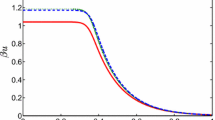Abstract
By the example of natural flames with energy excess, it is shown that these flames can exist in various systems and combustion regimes. The mere existence of some flames, such as cellular and spin flames, is caused by the excess energy. Mechanisms of energy concentration are also numerous. In addition to heat-transfer processes (conduction, convection, and radiation), energy concentration may be caused by mass-transfer processes, phase transitions, filtration, gas compressibility, etc. Examples of flames with artificial conditions for energy concentration demonstrate a wide range of possible applications of this phenomenon.
Similar content being viewed by others
REFERENCES
J. Masters and R. J. Webb, "The development of a recuperative burner for gas-fired furnaces” Proc. Roy. Soc. London, 393, 19–49 (1984).
F. J. Weinberg, "Combustion in heat-recirculating burners” in: Advanced Combustion Methods, Academic Press (1986), pp. 183–236.
F. Weinberg, "A brief survey of `excess enthalpy' combustion and some recent developments” in: Modern Problems of Combustion and Its Applications, Proc. 1st Int. School-Seminar, Minsk (1995).
B. Lewis and G. von Elbe, “On the theory of flame propagation” J. Chem. Phys., 2, 537 (1934).
Ya. B. Zel'dovich, Theory of Combustion and Detonation of Gases [in Russian], Izd. Akad. Nauk SSSR, Moscow–Leningrad (1944).
Ya. B. Zel'dovich, G. I. Barenblatt, V. B. Librovich, and G. M. Makhviladze, The Mathematical Theory of Combustion and Explosions, Plenum, New York (1985).
M W. Throng, The Science of Flames and Furnaces, William Clowes and Sons Ltd., London–Beccles (1962).
A. R. Jones, S. A. Lloyd, and F. J. Weinberg, “Combustion in heat exchangers” Proc. Roy. Soc., A, 360, 97–115 (1978).
”Regeneration for industry” in: R&D Digest, British Gas, No. 8 (1985/86), pp. 16–17.
S. A. Lloyd and F. J. Weinberg, “A burner for mixtures of very low heat content” Nature, No. 251, 47–49 (1974).
V. P. Mikheev and Yu. P. Mednikov, Burning of Natural Gas [in Russian], Nedra, Leningrad (1975).
T. Takeno and K. Sato, “An excess enthalpy flame theory” Combust. Sci. Technol., 20, 73–84 (1979).
B. Deshaies and G. Joulin, “Asymptotic study of an excess-enthalpy flame” Combust. Sci. Technol., 22, 281–285 (1980).
T. Takeno, K. Sato, and K. Hase, “A theoretical study on an excess enthalpy flame” in: Proc. 18th Symp. (Int.) on Combustion, The Combustion Inst., Pittsburgh (1981), pp. 465–472.
Y. Kotani and T. Takeno, “An experimental study on stability and combustion characteristics of an excess enthalpy flame” in: Proc. 19th Symp. (Int.) on Combustion, The Combustion Inst., Pittsburgh (1982), pp. 1503–1509.
V. S. Babkin, V. I. Drobyshevich, Yu. M. Laevskii, and S. I. Potytnyakov, “Mechanism of combustion-wave propagation in a porous medium with gas filtration” Dokl. Akad. Nauk SSSR, 265, No. 5, 1157–1161 (1982).
V. S. Babkin, V. I. Drobyshevich, Yu. M. Laevskii, and S. I. Potytnyakov, “Filtration combustion of gases” Fiz. Goreniya Vzryva, 19, No. 2, 17–26 (1983).
V. S. Babkin, “Filtrational combustion of gases. Present state of affairs and prospects” Pure Appl. Chem., 65, 335–344 (1993).
A. P. Aldyshin and A. G. Merzhanov, “Theory of filtrational combustion: General notions and state of research” in: Yu. Sh. Matros (ed.), Propagation of Heat Waves in Heterogeneous Media [in Russian], Nauka, Novosibirsk (1988), pp. 9–52.
O. V. Kiselev, Yu. Sh. Matros, and N. A. Chumakova, “Phenomenon of heat-front propagation in a catalyst layer” ibid., pp. 145–203.
G. B. Manelis, “Superadiabaticity” Priroda, Nos. 3–4, 43 (1996).
O. V. Kiselev, Yu. Sh. Matros, et al., “Organization of catalytical processes in the regime of heat-front formation and propagation in a stationary catalyst layer” in: Yu. Sh. Matros (ed.), Propagation of Heat Waves in Heterogeneous Media [in Russian], Nauka, Novosibirsk (1988), pp. 203–233.
"Development of technical requirements for a new technology of utilization of mining methane `Pushpull'” Scientific report on contract No. 36/92, Inst. Chem. Kinetics and Combustion, Sib. Div., Russian Acad. Sci., Novosibirsk (1992).
J. G. Hoffmann, R. Echigo, H. Yoshida, and S. Tada, “Experimental study on combustion in porous media with a reciprocating flow system” Combust. Flame, 111, 32–46 (1997).
N. Kubota and M. Ichida, “Combustion processes of propellants with embedded metal wires” AIAA J., 20, No. 1, 116–121 (1980).
S. S. Rybanin and L. N. Stesik, “Theory of combustion of a condensed propellant with a at heat-conducting element” Fiz. Goreniya Vzryva, 10, No. 5, 634–643 (1974).
A. G. Merzhanov, A. V. Dvoryankin, and A. G. Strunina, “New version of spin combustion” Dokl. Akad. Nauk SSSR, 267, 869–872 (1982).
B. V. Novozhilov, “Quasi-stationary theory of spiral combustion mode” Dokl. Ross. Akad. Nauk, 330, No. 2, 217–219 (1993).
V. I. Babushok, V. N. Simonenko, and V. S. Babkin, “Vortex combustion of Bengal candle” Fiz. Goreniya Vzryva, 29, No. 5, 103–104 (1993).
G. K. Shkadinskii, B. I. Khaikin, and A. G. Merzhanov, “Propagation of an oscillating front of an exothermic reaction in a condensed phase” Fiz. Goreniya Vzryva, 7, No. 1, 19–28 (1971).
A. A. Korzhavin, V. A. Bunev, et al., “On one regime of low-velocity detonation in porous media” in: G. D. Roy et al. (eds.), Gaseous and Heterogeneous Detonations: Science to Applications, ENAS Publ., Moscow (1999), pp. 255–268.
A. A. Korzhavin, V. A. Bunev, D. M. Gordienko, and V. S. Babkin, “Behavior of flames propagating over liquid films with metallic substrates” Fiz. Goreniya Vzryva, 34, No. 3, 15–18 (1998).
G. B. Manelis, E. V. Polianchik, and V. P. Fursov, “Energy technologies of combustion on the basis of the superadiabatic heating phenomenon” Khim. Interes. Ust. Razv., 8, No. 4, 537–545 (2000).
Author information
Authors and Affiliations
Rights and permissions
About this article
Cite this article
Babkin, V.S., Vierzba, I. & Karim, G.A. Energy-Concentration Phenomenon in Combustion Waves. Combustion, Explosion, and Shock Waves 38, 1–8 (2002). https://doi.org/10.1023/A:1014005014138
Issue Date:
DOI: https://doi.org/10.1023/A:1014005014138




